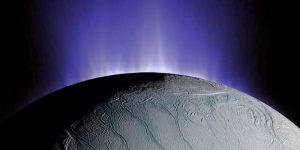Enceladus, one of 62 moons in a confirmed orbit around Saturn, has been in the spotlight since the Cassini spacecraft began orbiting Saturn, weaving among its moons and rings, in 2004. It was only when Cassini turned its instruments toward Enceladus that we learned of the moon’s powerful geysers and subsurface saltwater ocean. This week, scientists made another fascinating announcement about this Saturn moon. They say they now have strong evidence for a habitable area on the floor of Enceladus’ ocean. Their paper on this subject was published in the peer-reviewed journal Science on April 13, 2017.
The ocean of Enceladus is covered by a layer of surface ice. The moon’s geysers emerge from the subsurface ocean through cracks in the ice. When the Cassini spacecraft flew through plumes of gas and icy particles that make up Enceladus’ geysers on October 28, 2015, it detected a significant amount of molecular hydrogen. Scientists confirmed this week that the best explanation for this observation is that hydrothermal reactions occurring on Enceladus’ ocean floor. They may be similar to hydrogen-generating interactions taking place at Earth’s hydrothermal vents.
This discovery means the small, icy moon Enceladus might have a source of chemical energy that could be useful for living microbes, if any exist there.
Enjoy science news? Please donate to help EarthSky keep going.
Want to donate via Paypal or send a check? Click here.

Hydrothermal vents are common on Earth. They are fissures in the ocean crust through which geothermally heated water escapes. In other words, they are regions where water interacts with Earth’s magma. Earthly hydrothermal vents are home to many fascinating bacteria. Yellowstone’s Grand Prismatic Spring is an example of a hydrothermal area with a rich bacterial life.
Life has not been discovered beneath the icy crust of Enceladus. But the detection of hydrogen is strong evidence that all the necessary conditions for life are present. Hunter Waite of the Southwest Research Institute in San Antonio and lead author of the new Enceladus study, said in a statement:
Although we can’t detect life, we’ve found that there’s a food source there for it. It would be like a candy store for microbes.
Microbes on Enceladus could produce their energy through a chemical reaction known as methanogenesis, which consists of burning hydrogen and carbon dioxide dissolved in the ocean water to form methane and water.
This reaction is at the core of the development of life on Earth.


Scientists considered other explanations for Cassini spacecraft’s 2015 detection of molecular hydrogen within Enceladus’ geysers, for example, hydrogen leaking from the moon’s rocky core in ways other than hydrothermal reactions. The scientists who’ve studied these observations most closely, however, now feel that hydrothermal reactions are the best explanation.
Liquid water, an energy source, and the right chemicals (carbon, hydrogen, nitrogen, oxygen, phosphorus and sulphur) are the three main requirements for life as we know it. Now scientists discovered all of these life-ingrediants – except phosphorus and sulphur – on Enceladus.
The paper published in Science presents a detailed analysis of the possibility of methanogenesis on Enceladus. The calculations are inconclusive as to whether methanogenesis is happening or not around the hydrothermal vents of Enceladus. Nevertheless, this discovery is a big step in characterising the habitability of the ocean of Enceladus.

Bottom line: In April, 2017, scientists announced that molecular hydrogen in the plumes of Enceladus, one of Saturn’s moons, may be due to methanogenesis, a process that implies microbial life.
Enjoy science news? Please donate to help EarthSky keep going.











